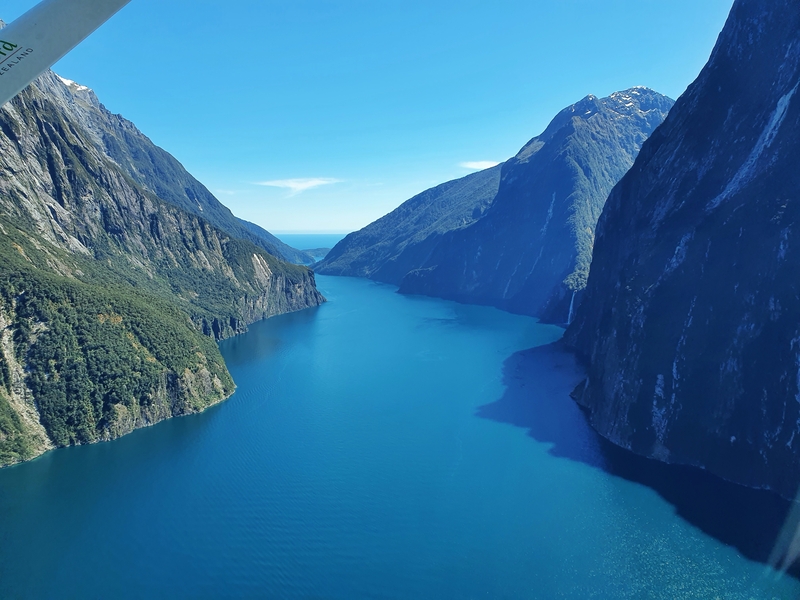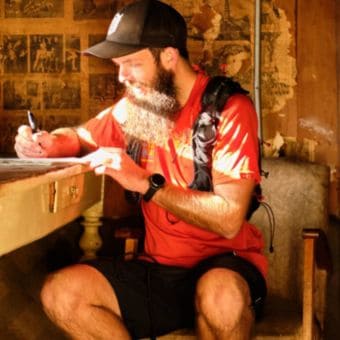It’s an amazing place for sure…but there’s more to Milford Sound than gorgeous scenery. These facts about Milford Sound will give you a bit more context about the 8th World Wonder.
FACTS ABOUT MILFORD SOUND
Quick Facts
Location: 44°38′53″S 167°54′20″
River purces: Cleddau River, Arthur River, Harrison River
Length: 15.1 kilometres (max)
Width: 1.94 kilometres (max)
Area: 25 sq. kilometres
Depth: 291 metres (max – yes cruiseliners can enter the fiord)
For most people there’s only one accommodation option in Milford Sound, Milford Lodge (which was built by the Sutherlands who you’ll read about later). But people do camp on the ridgeline leading up to Mitre Peak. This isn’t for the faint-hearted, but if you’re an experienced hiker it’s a pretty sweet campsite on the way to an epic peak.
Milford Sound is not actually a Sound. Sounds are formed by rivers, whereas fiords, like this one, are carved by glaciers. That’s why they named the park Fiordland National Park, to emphasize the fiords…not that you get to see them on many of the hikes in the park.
The fastest recorded windspeed in Milford Sound is 174 knots (322km/hr).
As of Christmas Day 2021 Milford Sound has some 3G coverage. As you can imagine, this didn’t go down well with everyone 🙂
The first European settler to Milford Sound John Grono was in 1823. Why so late when the likes of Captain James Cook and Abel Tasman so much earlier? When they were sailing around the coast, they simply thought they were passing a bay…not a massive fiord.
Grono called Milford Sound after he felt like it resembled the long narrow inlet in Wales, Milford Haven.
The Maori name for Milford Sound is Piopiotahi. It’s named after the piopio, a bird meaning ‘one native thrush’. The piopio is extinct thanks to the introduction of stoats and rats.
Milford Sound is often called the 8th Wonder of the World. This can be traced back to 1891 when Rudyard Kipling visited Milford Sound and made the statement.
In 2019, 870,000 people visited Milford Sound, and it’s expected that over 1 million people will visit anually in the coming years. There’s a fulltime population on 120 people! As with any popular destination, people will ask is Milford Sound worth visiting?
When you visit Milford Sound you’ll notice some peaks are rounded, and others are sharp more traditional peaks. The rounded ones are the result of being ground down by glaciers, whereas the sharp ones peaked above the ice.
Lady Bowen and Stirling Falls are the only permanent waterfalls in Milford Sound. Usually, there are a few more flowing, like Pixie and Fairy Falls (both were named by kids). When it rains though, dozens, if not hundreds of temporary waterfalls form along the steep sides of the fiord.
The Milford Track (the Great Walk opened in 1988) doesn’t give you epic views of Milford Sound like you might expect. The Milford Track was used by the Maori to access the Milford Sound where they went fishing, hunting, and collecting pounamu (greenstone). Keep this in mind before beginning the Track (which now better transport options), you might want to do another Milford Sound experience before or after your hike.
Milford Sound is the most northern of the 14 fiords in New Zealand. I find it fascinating the NZ fiords are on the same approximate latitude as the fiords in Chile.
Milford Sound is part of the UNESCO World Heritage Site, Te Wahipounamu, which was inscribed in 1990 (it’s a large site containing 3 National Parks).
There is a wide variety of wildlife within Milford Sound, including Bottlenose dolphins, Hector’s dolphins, rock lobster, NZ Fur Seals, Blue Duck (i).
Everyone learns quickly that Milford Sound is wet. The wettest inhabited place in New Zealand. They get about 7000mm (7 metres) of rainfall every year, with rain 183 days every year. In 2020 Milford Sound recorded 68mm of rain in 5 mins, one of, if not the heaviest downpour recorded.
Milford Sound is the only fiord in NZ with a road leading to it (you have to catch a ferry to reach the Wilmot Pass road leading to DOubtful Sound). Despite first being flouted in 1889, it wasn’t until 1935 that construction of Homer Tunnel was started to connect Milford Sound by road. 19 years later, in 1954 the road connecting the Hollyford Valley and Cleddau Valley was opened.
Bowen Falls is the most spectacular, and tallest, waterfall in Milford Sound. THe waterfall provides power and electricity to the small village in Milford.
The first full-time resident of Milford Sound was Daniel Sutherland (and his dog) from Scotland as of 1877. Eventually, he got married and his wife, Elizabeth, joined him in 1890. Together they opened the first hotel in Milford Sound to accommodate the growing foot traffic to the area.
Milford Sound is a haven for sandflies. If you’re staying there, particularly in the summer, make sure you know what you’re in for!
And there we go. The history of Milford Sound is relatively well documented, so that’s just a slice of fun info and facts about Milford Sound to get you started.
If you have any questions about Milford Sound, email jub@churnewzealand.com or leave a comment below. Not sure how to get to Milford Sound? This post will help you out.
WHAT TO READ NEXT:
WALKING THE NEARBY HOLLYFORD TRACK
Hey, it’s Jub here. I’m the guy behind Chur New Zealand, helping you have the best time hiking, trekking, walking…whatever you want to call it…in NZ. I’m based in Queenstown and am always out and about exploring trails, old & new. If you have any questions, reach out.



this is a great place
100% agree with ya Bruce!